
©Amy Lewis
Yew
The Yew is a well-known tree of churchyards, but also grows wild on chalky soils. Yew trees can live for hundreds of years, turning into a maze of hollow wood and fallen trunks beneath dense foliage.
Scientific name
Taxus baccataWhen to see
January to DecemberSpecies information
Category
Statistics
Height: up to 20mCommon.
